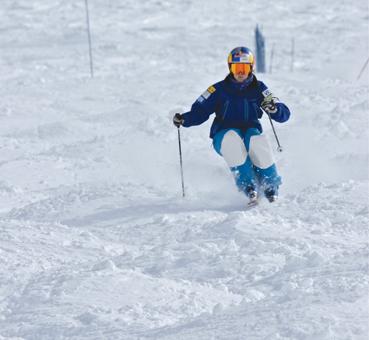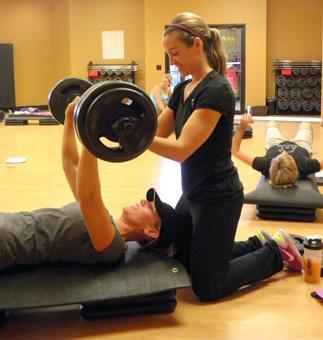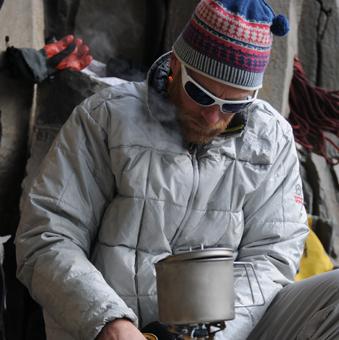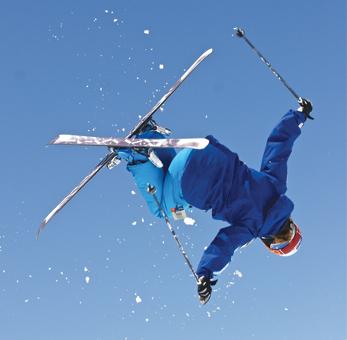Top Performance with Montana's Pro Athletes
Fitness Tips...
For Olympian freestyle skier Heather McPhie, world-class mountaineer Conrad Anker, and ultra-distance trail runner Mike Foote, staying fit and at peak performance is more than a fitness goal. It goes beyond the sport and becomes the key to a healthy lifestyle and the basis of their success.
Where most of us struggle to get in a couple of workouts a week, these folks are typically focused on a couple of workouts a day. “Staying fit at this level involves several different facets,” said McPhie whose health and fitness training programs includes aerobic, strength, and conditioning programs both on and off the snow as well as yoga, Pilates, trampoline, water work, and massage therapists.
Probably not going to be an option for the majority of us given our work, family, and “honey-do” lists.
But have no fear, we ordinary mortals can still feel like super athletes. With the help of three Montana personal trainers here are some pointers on how to incorporate a few of McPhie’s, Anker’s and Foote’s highly successful habits into our weekly health and fitness regime.
For these Montana star performers, staying in shape centers around three common denominators: motivation, maintaining energy levels through food, hydration, and sleep, and by focusing on a variety of fun, injury-free training sessions.

Motivation
“Your mindset makes a huge difference in how you feel physically,” said McPhie. She believes so strongly about this she keeps a daily mental strength journal and works regularly with a mental strength coach.
“I think long lasting motivation comes with success,” said Missoula AFAA-certified fitness trainer Jamie Beeson. Anker, Foote, and McPhie didn’t start as athlete phenomenons but built their success one small step at a time. Beeson noted that it’s the same thing for you and me. We need to define what success is for us and make every step along the way a win. To build that success, Beeson tailors goal-specific, measurable, and accountable programs for her clients.
“You have to give a lot of thought to your mental commitment each day,” said Bozeman ACSM-certified personal trainer Leah Vogel. Positive self-talk is one of Vogel’s main roles and her clients’ main goals. On a daily basis Vogel recommends listening to good music before and during your workouts, clipping out fitness articles that motivate you, taking part in group fitness or small group personal training, and working out first thing in the morning.
NASM- and ACE-certified instructor Paul Taylor has been training in Billings for over 25 years, “Most of my clients would rather let themselves down than miss an appointment with me.” If meeting a personal trainer is out of reach financially, consider a commitment to meeting a friend at the gym to taking your dog for a daily walk.

Maintaining Healthy Energy Levels: Food, Hydration, and Sleep
Some of us might feel as if we’re running a hundred miles but ultra-trail runner Foote actually does. Nutrition, hydration, and sleep play major roles in his level of performance. Foote focuses on eating simple whole foods (though he too suffers from a self-described wicked sweet tooth—thank you, Big Dipper). During workouts he relies on hourly 200-300 calorie carb snacks and drinking lots of water supplemented with electrolytes.
“Long-term health and energy comes from a high quality diet consisting of whole foods close to the source and good hydration,” said Vogel. Regarding short-term energy for your workouts, Vogel notes the number one reason for decreased performance is dehydration.
“Winter is tough,” added Taylor. “People aren’t as thirsty when they’re cold so they don’t drink enough. Water regulates your temperature and keeps your joints lubricated.” For Beeson drinking water is an essential habit, recommending 64 ounces or more per day depending on your level of workout. “Water is they purist source of hydration; it’s about more than quenching thirst. It also aids digestion, adding to muscular strength and metabolizing fat,” noted Beeson.
Both Vogel and Beeson encourage their clients to track their nutrition via a food log and use a couple of different free Web sites, including Livestrong.com, sparkpeople.com or myfitnesspal.com. These sites break down the nutritional value of the food you eat. “Food is more than half the battle in increasing health and fitness levels,” noted Beeson, “It’s nearly 70% nutrition and 30% exercise.”
“If you’re lifting weights and not getting enough protein you’ll do more harm than good,” cited Taylor. “Protein is necessary to rebuild your muscle tissue and carbs are a basic source of energy for the brain anda healthy central nervous system.” In Taylor’s opinion the optimum pre-workout meal should be a low-fat, low-fiber, moderate-carbohydrate affair.
For McPhie, sleep plays an integral part in her performance, health and fitness. “If I get eight hours or more, my body recovers well, and I wake up feeling rested. Less than that I start to feel run down and it’s hard to stay pushing at this level.”
“Eight hours is a beautiful thing,” said Vogel, noting the difficulty of attaining this for many people. “The body needs sleep to regenerate on a cellular level; you won’t see gains in performance if you’re having trouble getting to sleep.” Vogel recommends trying a yoga class, learning how to breathe for relaxation, and trading some of TV time for a few more z’s.

How to Train Injury-Free
For Anker the best way to get in shape is not to get out of shape and the best way to stay injury free is to avoid overuse. He said, “From a physical standpoint ice climbing is quite a challenge. First, one must embrace the cold. Knowing how to keep warm and energized allows one to “feel the pump” as one hangs onto the ice tools. The psychological demand of operating in a risky environment heightens one’s senses. But one must stay on the ball; mistakes are costly.”
While Anker, Foote, and McPhie spend most of their time training within their sport-specific areas of expertise, they also add in a mix of workouts to keep their bodies and mind balanced and interested. All train outdoors as much as possible.
“There’s a difference between increasing and maintaining our fitness levels,” cited Beeson, who recommends aerobic training four-six times/week between 30-60 minutes with an elevated heart rate and strength training two-three times/week hitting all major muscle groups. Beeson starts her clients working out with two cardio and one strength training session per week. She also works to keep fitness fun for both herself and her clients. “I’m always looking for new ideas; my clients think I dream these things up in my sleep.”
Like her clients, fitness professional Vogel has ebbs and flows too, “A key factor is having a challenge or goal to keep me motivated. We need something quantifiable, we need something joyful and fun—I think it’s all about the goal to keep you going. I always need a little bit of a challenge.” Each year Vogel creates a new fitness goal for herself, as she does for her clients. Vogel’s advice to stay injury free: always warm up and learn the difference between the beneficial “burn” or muscle pain and detrimental joint and sharp pain.
For Taylor training his clients may start slow, “Walk before we run,” he said, “Then run fast.” Taylor lives by the adage: “In the game of life I don’t want front seats,
I came to play,” and perhaps so should we.

Tips for staying fit and injury free in the winter:
1) Winter is a great time to work on sport-specific strength to make you faster, stronger and less prone to injury. Consider personal training or programs with sport-specific strength training from coaches and personal trainers.
2) Stay active and embrace winter with sports such as cross-country skiing, backcountry skiing, snowshoeing, running, hockey, and even snow biking!
3) Don’t let darkness be an excuse to sit around. By getting a good head lamp or bike lights, you’ll be surprised how much fun night skiing, running and biking can be.
Have fun and I’ll see you out there!
Rob Amrine, MD - Western Montana Clinic / Sports Medicine
For serious athletes like Conrad Anker and the rest of us “weekend warriors,” regular therapeutic massage has many benefits. These include relieving muscle soreness, improved range of motion, relieving adhesions, increased circulation, and decreased blood pressure. Massage has psychological effects as well by lowering stress and increasing mental focus. These effects are significant for anyone, but can be of special importance to the athlete looking for ways to recover faster, prevent injuries, and improve performance.
Heather Ripplinger, Licensed Massage Therapist, Canyon River Spa
Mike Foote
When I do injure myself or get hurt, I use the best drugs I can find: Ice and Rest!
Nothing promotes healing tendonitis or a pulled muscle better. It’s hard in the moment to back off of activity due to injury,
but it is always the right call for the long term. If that doesn’t do the trick, I go and see my physical therapist.
I see it as an investment in my health and it is worth it to me.
Heather McPhie
I typically get massage at least once a month, but two times per month I have found is ideal for me with my workout load. It helps with injury prevention, and helps me check in with my body and make sure I am in alignment.
Conrad Anker
Running and hiking outdoors are my core activities. I try to climb two or three times a week.
I do yoga once every two weeks and stretch before going out. I am particular about keeping my hands warmed up and strong.
--












Leave a Comment Here